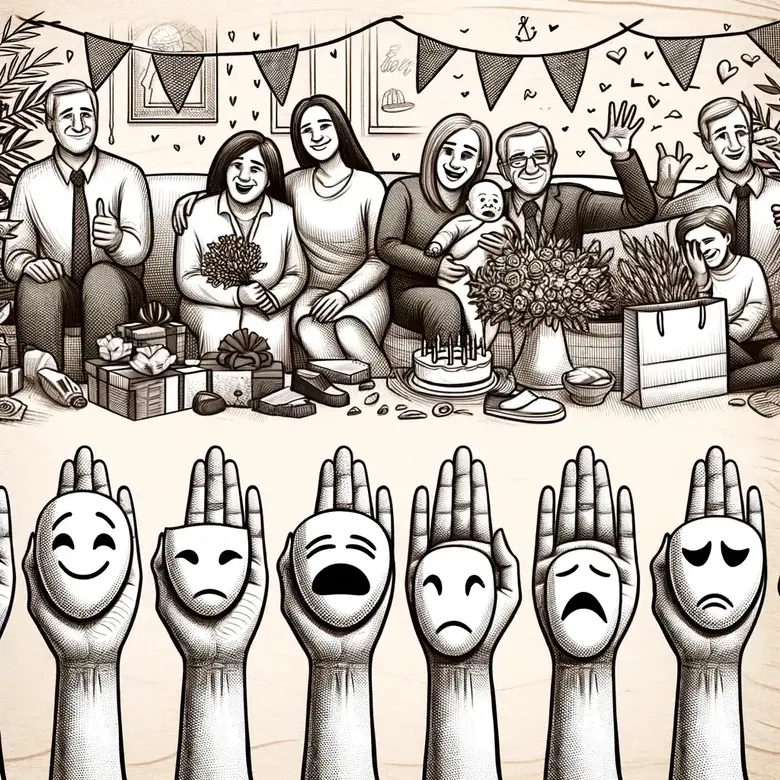Revealing Emotional Labor: The Hidden Mental Labor In All Facets Of Life

I was at a dinner party recently, surrounded by happy faces and hearty laughter. Yet, amidst the joy, my attention was caught by Sarah, the host. She was smiling, yes, but her eyes told a different story, one of exhaustion and unspoken responsibilities.
She was the epitome of grace. She ensured everyone felt welcomed. However, the weight of this unseen labor was palpable. This was at least to someone attuned to the subtleties of human interaction.
Now, tell me, have you ever felt drained and zapped of vitality? Have you found yourself unable to identify the source of your fatigue?
You’re not alone. Most people attribute such feelings to physical exertion, overlooking the mental and emotional toll that often goes unnoticed: emotional labor.
What is emotional labor?
The term “emotional labor” refers to the exertion involved in managing and tempering our emotions. We do this to adhere to social norms or job expectations. It’s a form of labor that often doesn’t get acknowledged.
It plays a critical role in our emotional state and overall well-being. And let me be clear. The mental load of this kind of labor can be just as exhausting as any physical task. It can be even more exhausting.
As we venture further into this topic, we’ll dissect the different dimensions of emotional labor. This includes the workplace and intimate relationships.
We’ll also explore ways to manage this invisible burden to improve both your emotional well-being and your interactions with others. After all, awareness is the first step toward transformation.
So, are you ready to shed light on this often-overlooked aspect of your life?

The Evolution of “Emotional Labor”
Arlie Hochschild’s The Managed Heart: Commercialization of Human Feeling, published in 1983. It introduced the world to the concept of emotional labor.
Hochschild’s research highlighted how workers, especially in service industries, manage and manipulate their emotions to meet job expectations.
Since then, this idea has expanded beyond the service industry, becoming relevant in everyday social and professional settings. Her groundbreaking work was once thought to apply primarily to specific roles like flight attendants.
We now see it impacting everyone. This ranges from a CEO in a boardroom to a mother managing household dynamics.
Hochschild’s original focus was narrow, but emotional labor has evolved into a concept that pervades many aspects of our lives. Emotional labor occurs whether it’s managing your emotions at a family gathering.
It also happens when presenting a calm facade at work. It is always there, shaping our daily experiences.
The Hidden Cost of Emotional Labor Across Professions
Corporate Executives
High levels of emotional labor required to maintain professionalism and control.
Healthcare Professionals
Burnout and emotional exhaustion are common due to high emotional demands.
Customer Service Reps
Emotional labor required to handle frustrated clients leads to high emotional fatigue.
Non-Binary Individuals
Emotional labor often involves educating others about their identity.
BIPOC Communities
BIPOC individuals face disproportionate emotional labor due to systemic inequalities.
emotional labor in the workplace
Imagine being in a corporate meeting where tensions run high. A manager might be suppressing frustration, putting on a brave face, and projecting calm to maintain professional decorum. That’s emotional labor in action.
A study by the American Psychological Association (APA) revealed that 60% of customer service representatives experience emotional exhaustion. This often leads to burnout. Healthcare professionals aren’t far behind.
A survey by the American Medical Association (AMA) found that 50% of them report burnout. Emotional labor is a significant factor.
Even executives aren’t immune. Corporate leaders often engage in emotional labor to maintain control. They do it to maintain professionalism, according to the Harvard Business Review.
Emotional labor isn’t limited to the workplace. In social situations, emotional demands can be just as draining. A study showed that 75% of people feel emotionally depleted after attending social events. This reflects the invisible effort they exert to meet social expectations.
Emotional Labor in Intimate Relationships
Emotional labor doesn’t stop when we clock out of work. Take Emily, who wakes up early to prepare for her day and ensure her family’s needs are met.
She takes care of breakfast. She also provides emotional support to her partner, who’s stressed about a work project. This scenario mirrors what many people experience in their daily lives, managing their emotions and those of their loved ones.
Women have historically carried the bulk of emotional labor, both in personal and professional settings. Recent studies indicate that men also engage in emotional labor, although societal norms often discourage them from expressing it openly.
For non-binary individuals, the emotional toll is even more pronounced. According to a study by the National Center for Transgender Equality, they often face an additional emotional burden. They frequently educate others about their identities.
In relationships, emotional labor can be overwhelming, especially when one person disproportionately manages the emotional well-being of others. By bringing awareness to this hidden workload, you can better navigate these emotional dynamics and find balance.

Emotional Labor in Social Interactions
Have you ever felt utterly exhausted after attending a social event, even though you didn’t exert yourself physically? That’s emotional labor at work. In social interactions, we often adjust our emotions to fit the expectations of the situation.
You might laugh at jokes you don’t find funny. You might also show interest in conversations that bore you. All this is done to maintain social harmony.
Social media adds another layer to this dynamic. Research from the Pew Research Center shows that 70% of adults in the U.S. use social media, where they curate their online personas to meet social expectations.
This curation is a form of emotional labor that can be just as taxing as in-person interactions.
So, what are these norms costing you? Are you aware of how your emotional state fluctuates as you navigate these social norms?
In unfolding this subject, we’re not just identifying patterns; we are also permitting ourselves to question them. By becoming aware of the invisible work, you can choose how to engage in this complex emotional ecosystem.
Subscribe to Create Higher Vibrations!
Get Inspiration and Practical advice straight to your inbox.
The Unsung Heroes: Who Takes on the Heaviest Load?
Let’s talk about the often-overlooked role that race plays in emotional labor. BIPOC (Black, Indigenous, and People of Color) communities frequently carry a disproportionate emotional burden. The American Journal of Public Health published a study.
It reveals that BIPOC individuals often experience higher levels of emotional exhaustion. This is due to the systemic inequalities they face daily. Emotional labor for these communities goes beyond the personal sphere; it intersects with societal expectations and prejudices.
Women often provide emotional support in family settings. Non-binary and marginalized individuals face additional burdens in educating others about their identities. Emotional labor is rarely acknowledged. It is deeply felt.
Consider this:

Consequences of Emotional Labor
The hidden costs of emotional labor are staggering. A customer service representative like Sarah might end her day feeling emotionally drained after handling countless calls from frustrated customers.
Studies show that 60% of service workers report emotional exhaustion, often without recognition of the toll it takes.
Healthcare professionals are similarly affected. According to the AMA, half of healthcare workers report burnout, largely due to the emotional demands of their jobs.
Even in corporate settings, executives experience emotional fatigue from constantly managing their public personas.
The Domino Effect of Ignoring Emotional Labor
When emotional labor goes unrecognized, the consequences ripple through every aspect of life. From burnout to strained relationships, the effects are profound.
In workplaces, emotional labor imbalances can foster toxic environments, affecting morale and productivity. In personal relationships, the unequal distribution of emotional labor can lead to tension and resentment.
Sharing the Emotional Load
The first step in addressing emotional labor is acknowledging its existence. Whether it’s at work or in personal relationships, emotional labor should be recognized and shared more equitably.
Educating yourself and having open conversations can lead to a more balanced emotional workload.
Closing Thoughts: Your Role in the Emotional Equation
Emotional labor isn’t just a burden; it’s a shared responsibility that affects every aspect of our lives. Recognizing the invisible work you and others do daily is the first step toward redistributing the load.
In workplaces and relationships, open dialogue and acknowledgment of emotional labor can lead to a healthier life. It can also create a more balanced life for everyone involved.
Are you ready to take the next step in understanding and sharing the weight of emotional labor? The path ahead begins with awareness and leads to action.








